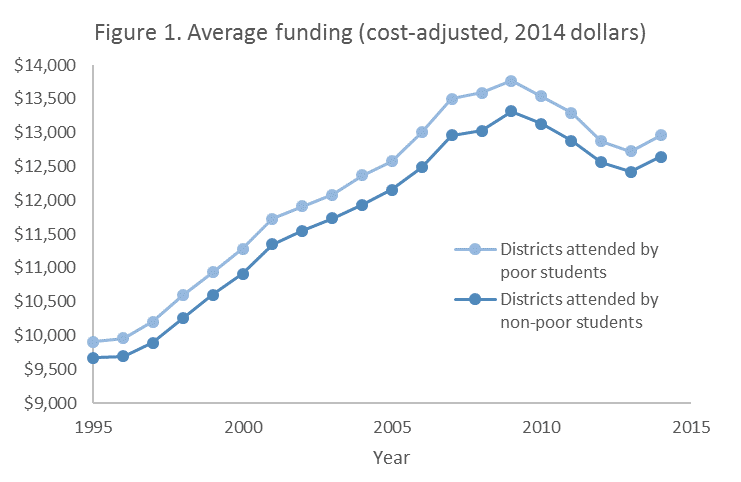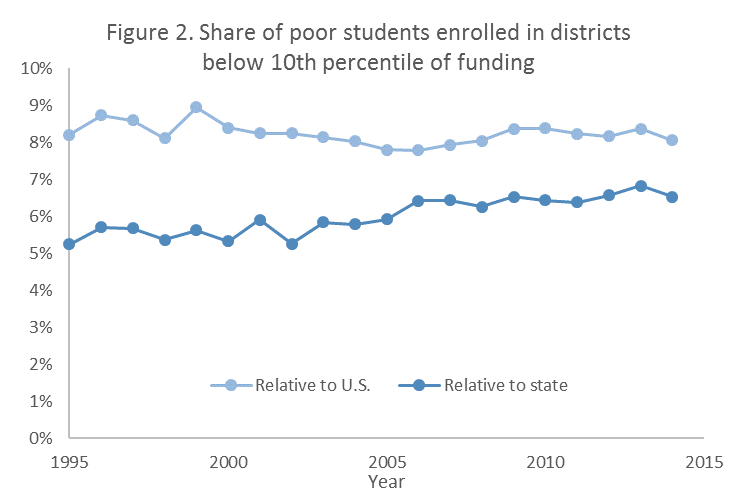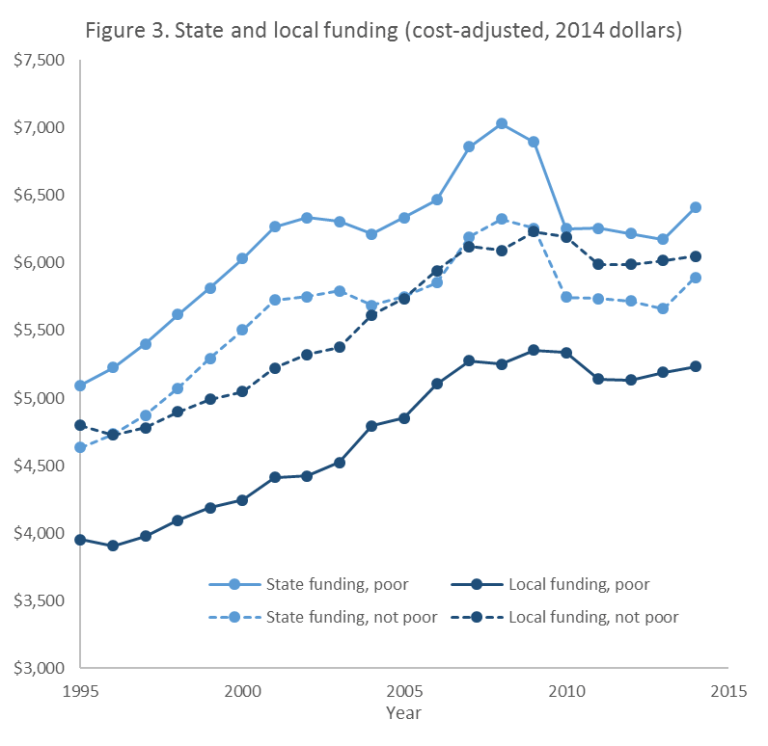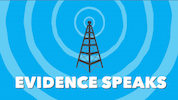
Policymakers, advocates, and the public have long been concerned with inequities in funding levels between schools attended by students from low-income families and their more affluent peers. School funding has received increased attention in recent years as multiple high-quality studies have found that school funding reforms initiated by courts and state legislatures improved the outcomes of disadvantaged students, both in terms of academic achievement (test scores) and attainment (high school graduation and college enrollment). [1]
School funding systems vary by state, but in the typical state, the financing of K-12 education is shared roughly equally by the state and local governments (with the federal government covering less than 10 percent of the cost). Most states have provisions designed to target additional funding to districts attended by low-income students, with the goal of making up for these districts’ limited capacity to raise revenue through property taxes and other local sources. [2]
States vary widely in the degree to which they succeed at producing a progressive distribution of school funding. My Urban Institute colleagues and I developed a new measure of funding progressivity, which we describe and present in a recent interactive data feature and research brief.
The measure is a simple one: we calculate the average per-pupil funding levels of districts attended by poor students (those from families below the federal poverty level), compared to the funding of districts attended by non-poor students. Specifically, we calculate two weighted averages of the funding of all regular school districts in each state: one using the number of poor students in each district as weights, and the other using the number of non-poor students as weights. We adjust funding levels in each district using average wage levels in its local labor market. [3]
In this report, I use the same methodology to produce a national overview of the distribution of school funding in the U.S., both in the most recent year for which data are available (2013-14) and over time since 1994-95. The national distribution of funding reflects both the distribution within states, as well as how students are distributed across states. For example, the average state could have progressive funding, but at the national level funding could still be regressive if poor students are substantially more likely to live in states with low funding levels.
Nationwide, per-student K-12 education funding from all sources (local, state, and federal) is similar, on average, at the districts attended by poor students ($12,961) and non-poor students ($12,640), a difference of 2.5 percent in favor of poor students.
Figure 1 shows that this difference has not changed much since 1994-95, when funding levels were lower (less than $10,000 in 2014 dollars) but the difference between poor and non-poor students was similar in percentage terms (2.4 percent). Average progressivity nationwide did rise in the years prior to the Great Recession, with the poor/non-poor difference peaking at 4.3 percent in 2007-08.

Examining the funding of districts attended by the average poor vs. average non-poor student may miss what is happening in the extremes of the distribution. For example, perhaps poor students are concentrated in the worst-funded districts. I tackle this issue by calculating the share of poor students that are enrolled in the 10 percent of school districts with the lowest funding levels in their state (I repeat the calculation looking at the bottom 10 percent nationwide). If poor students are perfectly evenly distributed across districts, 10 percent of such students would attend schools in the bottom 10 percent of districts.
I find that fewer than 10 percent of non-poor students were enrolled in low-spending districts in every year since 1994-95, a rate 1 to 3 percentage points lower than the comparable rate for non-poor students in every year. Figure 2 shows that the share of low-income students attending (relatively) poorly funded districts has not changed much over the past 20 years.

Finally, I examine the distribution of state and local funding over time. Figure 3 shows that the relative funding provided to the districts attended by poor vs. non-poor students by state and local governments has not changed much. State funding levels are about 10 percentage points higher for poor students than non-poor students, and local funding is about 15 percent lower. Local funding does appear to have become modestly less regressive over this period, with the poor student disadvantage falling from 18 percent in 1994-95 to 14 percent in 2013-14.

The interpretation of these results will likely vary based on the reader’s expectations. Someone expecting to find widespread evidence of “savage inequalities” will be pleasantly surprised to learn that, on average, poor students attend schools that are at least as well-funded as their more advantaged peers. They might also be heartened by the fact that the gap in local funding of districts attended by poor vs. non-poor students has narrowed rather than widened during a period of rising economic inequality.
But there are good reasons to believe that it is more expensive to provide the same quality of education to disadvantaged children—in other words, funding that is equal may not be equitable. For example, schools serving disadvantaged children likely find it harder (or more expensive) to recruit and retain high-quality teachers. [4] Additionally, poor children may have higher rates of disabilities or social service needs that require resources to appropriately address.
From this perspective, the fact that overall funding progressivity remains low despite two decades of reforms enacted by courts and state legislatures suggests a troubling lack of progress on equitable funding of public schools. This finding is consistent with our state-level analysis, which shows that states where the distribution of education funding is strongly progressive are the exception rather than the norm.
These descriptive findings based on district-level data can only depict patterns of school funding in broad strokes. They do not tell us how funding should be distributed, or even how it is currently distributed across different schools within the same district. [5] In the meantime, the available evidence provides compelling reasons for researchers, policymakers, and practitioners to pay careful attention to how much education funding is available, how it is distributed, and how it is spent.
— Matthew M. Chingos
 Matthew M. Chingos is a Senior Fellow at the Urban Institute.
Matthew M. Chingos is a Senior Fellow at the Urban Institute.
This post originally appeared as part of Evidence Speaks, a weekly series of reports and notes by a standing panel of researchers under the editorship of Russ Whitehurst.
The author(s) were not paid by any entity outside of Brookings to write this particular article and did not receive financial support from or serve in a leadership position with any entity whose political or financial interests could be affected by this article.
Notes:
1. A recent article by Matt Barnum (available at http://www.chalkbeat.org/posts/us/2017/06/06/devos-says-school-spending-and-student-outcomes-arent-related-but-recent-research-suggests-otherwise/) contains links to several recent studies. Two of the most prominent include C. Kirabo Jackson, Rucker C. Johnson, and Claudia Persico. 2016. “The Effects of School Spending and Economic Outcomes: Evidence from School Finance Reforms.” Quarterly Journal of Economics 131 (1): 157–218; and Julien Lafortune, Jesse Rothstein, and Diane Whitmore Schazenbach. 2016. “School Finance Reform and the Distribution of Student Achievement.” Working paper. University of California, Berkeley.
2. “Funded: State Education Funding Policies for all 50 States,” EdBuild, accessed May 19, 2017, Funded.edbuild.org; Thirty-five states provide additional funding to districts based on enrollment or concentration of low-income students (or both).
3. In practice, this adjustment does not affect our overall conclusions.
4. https://cepa.stanford.edu/sites/default/files/CR03.BLLW_.TeacherMkts.pdf.
5. This important limitation will begin to be addressed in the coming years, as the Every Student Succeeds Act (ESSA) requires the publication of school-level finance data beginning in December 2018 (https://www.future-ed.org/work/with-new-data-school-finance-is-coming-out-of-the-dark-ages/). However, the production of useful data is likely to face significant implementation challenges (https://www2.ed.gov/rschstat/eval/title-i/quality-expenditure-data/report.pdf)


